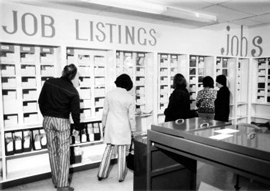Learn About the U.S. > Work and Workplaces in the U.S. > Employment > Unemployment insurance

|

Employment
- Social Security and Retirement
- Retirement Age and Social Security
- Working at Home
- Longer Years of Retirement
- Employment trends
- Foreign workers in the United States
- Mexican Workers in the United States
- Workplace Safety Standards
- Work-related Injuries and Deaths
- Growth of Large Corporate Farming
- Union Membership Across the United States
- Laws Regarding Working Women
- Labor Contracts in the United States
- Right-to-Work Laws
- Public worker unions in the United States
- Unemployment insurance
- Equal Opportunity Employment Laws
- Workers’ Compensation
- Minimum Age for Agricultural Employment
- Minors in the Workplace
- Minimum Wage
- Employment of Persons with Disabilities
- Major Equal Employment Legislation in the U.S.
- Employment in the Service Sector
- Unemployment
- State’s Unique Worker’s Compensation Laws
- Life on Unemployment
- Minimum Wage and Poverty
|

Job seekers review listings posted in the
California Employment Development Department in the
1960s.
Photo Courtesy of the California Employment
Development Department.
Unemployment insurance
In the United States, companies do not feel obligated to keep employees on their payroll when business is bad. Instead, the workers are "laid off" temporarily, until economic conditions improve. This means they have not been fired from the job, but they cannot work or be paid until the company can afford to call them back to work. While they are working, both employers and employees pay a small monthly tax into a government fund. When workers are laid off, they can receive money from this fund. The government also puts additional money into the fund so that there will be enough money to support workers when they are laid off. The United States unemployment insurance program began in 1935 as part of the New Deal. The main goal of the program was to help workers who had been laid off. A second goal was to keep money flowing in the economy and prevent further loss of jobs by giving money to laid off workers so they could buy food and pay rent.
|
|
|
| Download Podcast in
English
| Japanese
|
|
Document |
Audio-Video |
Chart |
Picture |
Map
|
|

